Understanding football formations is key to appreciating the strategies behind the beautiful game. This article will dive into the 1-4-1-3-2 formation, a versatile setup that balances defense and attack. This formation features a strong defensive line, a holding midfielder to break up opposition plays, a dynamic trio in the midfield, and a pair of forwards to spearhead the attack. Whether you’re a coach, player, or fan, exploring the intricacies of the 1-4-1-3-2 formation will enhance your tactical knowledge and game-day experience. Let’s break down how this formation operates and what its advantages are on the pitch.
High Pressing in the 1-4-1-3-2 Formation
When pressing in the 1-4-1-3-2 formation, the main idea is to push the opposition to one side and leave the opposition defenders on the far side open. This is possible because the pass from one side to the other is too difficult for the ball-holder to make, and if he makes it, the players will have enough time to come across and win the ball. The benefit of this system is that it gives you a numerical advantage against the opposition striker/strikers, which gives you more control when defending long balls.
High press against a back four
Against a back four, the two strikers will be responsible for the two center-backs and the wide midfielders are the ones who have to move depending on where the ball is. If the ball is on the left side, the left midfielder has to come out to the opposition right-back, and the right midfielder tucks in. If the ball is on the right side, the right midfielder has to come out to the opposition left-back, and the left midfielder has to tuck in.
Pressing Against a 1-4-2-3-1
The ball-side wide-midfielder pressures the opposition ball-side fullback, the number-ten comes across to the ball-side holding midfielder, and the far-side wide-midfielder tucks in to control the opposition far-side holding midfielder.
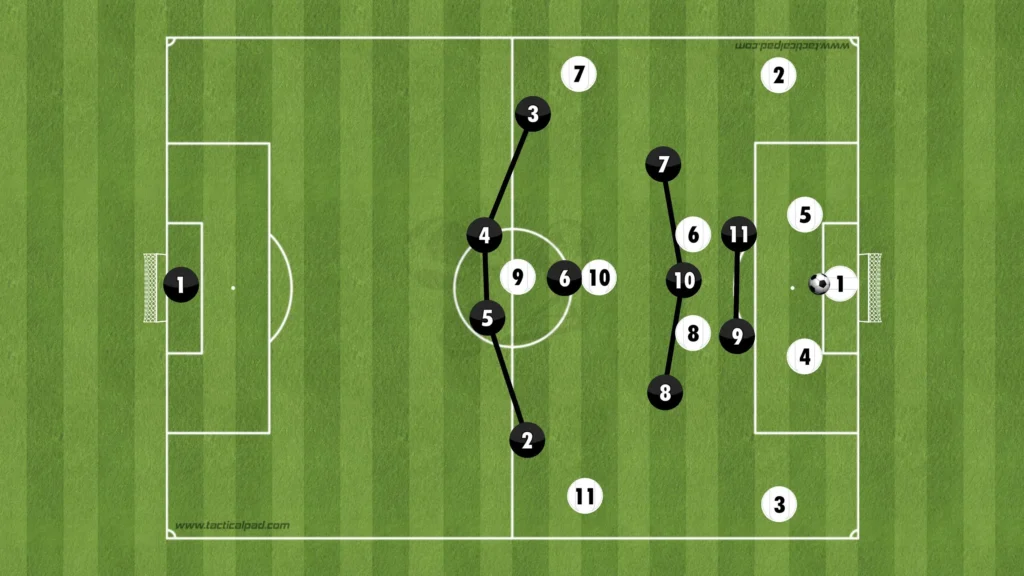
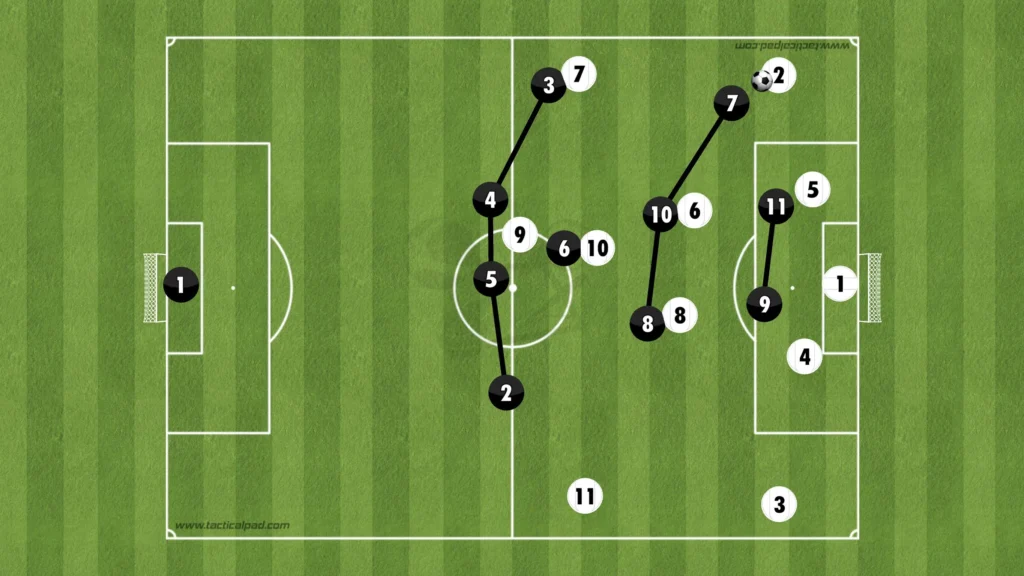
Pressing Against a 1-4-3-3
The ball-side wide-midfielder pressures the opposition ball-side fullback, the holding midfielder pushes over on the opposition ball-side number-eight, and the far-side wide-midfielder tucks in to control the opposition far-side number-eight.
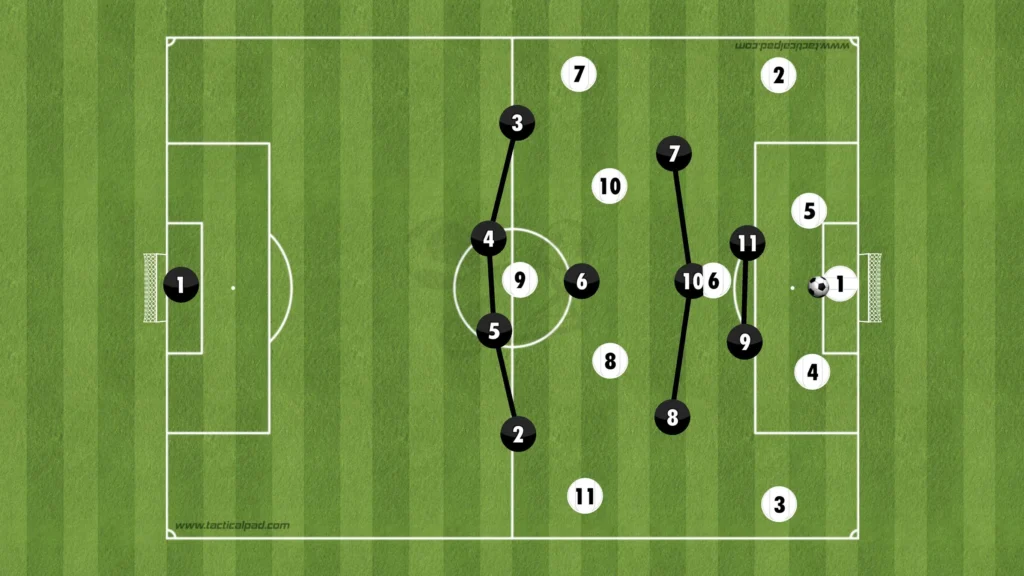
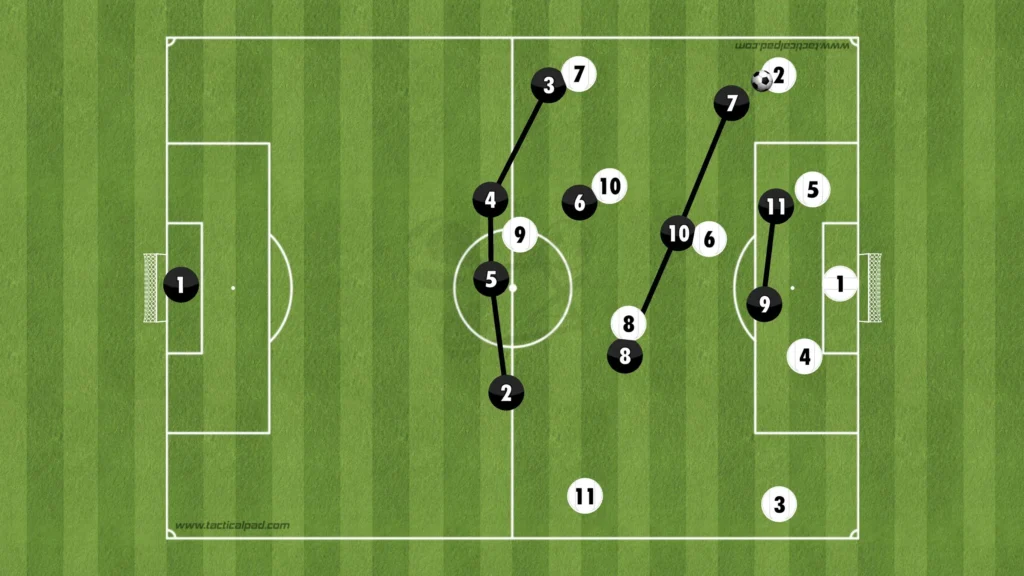
Spain pressed in a 1-4-1-3-2 formation during the Euros. Here, they win the ball high up against Croatia, who build in a 1-4-3-3 formation.
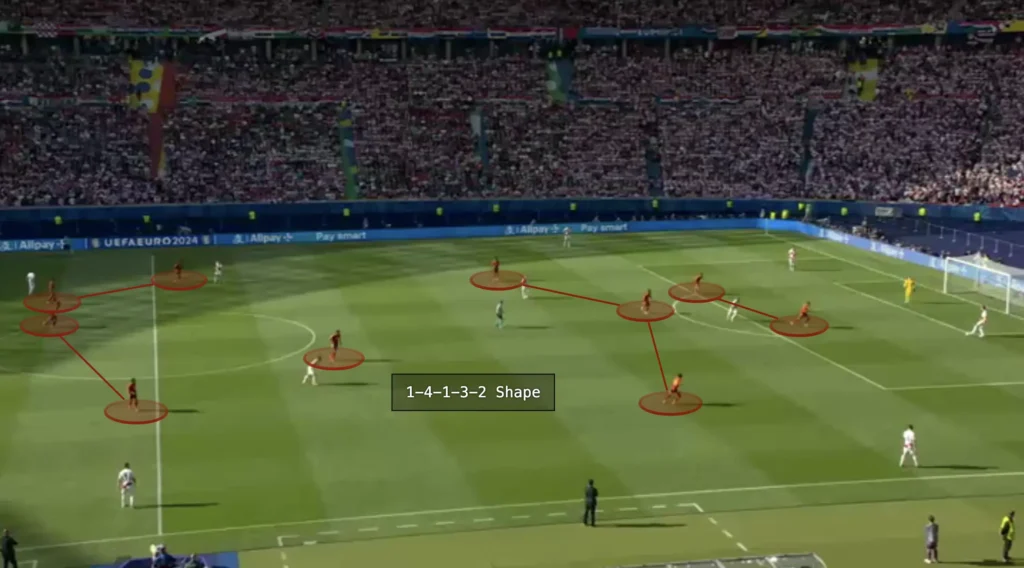
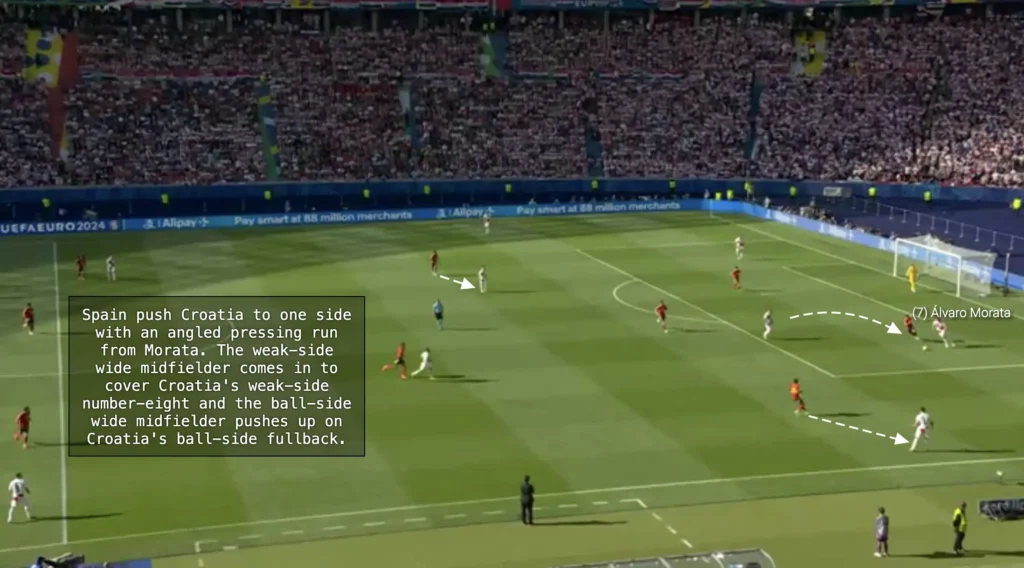
Here is another example from their game against Germany.
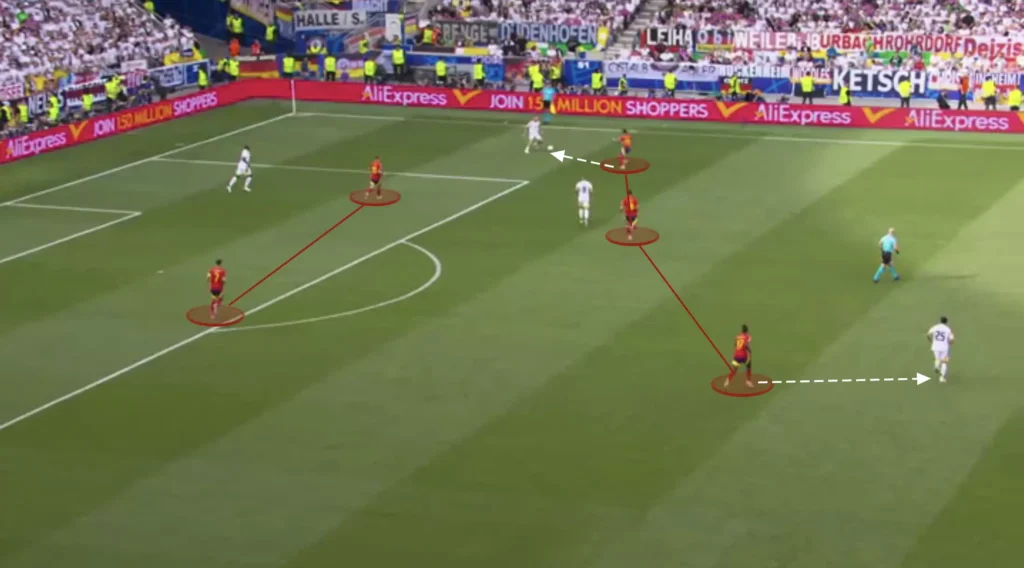
High press against a back three
Pressing against a back three works similarly to pressing against a back four. The idea here is again to push the opposition to one side and leave the other side open. The strikers are numerically inferior against the opposition backline, which means the far-side center-back has to be left open. The far-side striker closes the back-pass to the central center-back and the ball-side striker presses the ball-side center-back as hard as possible.
Issues with the switch of play
The most important thing when pressing in a 1-4-1-3-2 formation is to close the switch of play. If the ball gets switched from one fullback to the other, the two wide midfielders have to run way too far for the team to keep pressing the opposition. Therefore, the strikers have to force the ball to one side and then close the back pass to the center-backs. The midfielders also have to be very close to their opponents, not allowing them to turn and switch the play.
In this situation, Spain’s players are not aggressive enough and give too much space for Gremany’s midfielders. Emre Can can easily play out of the press by finding the German left-back with a switch of play.
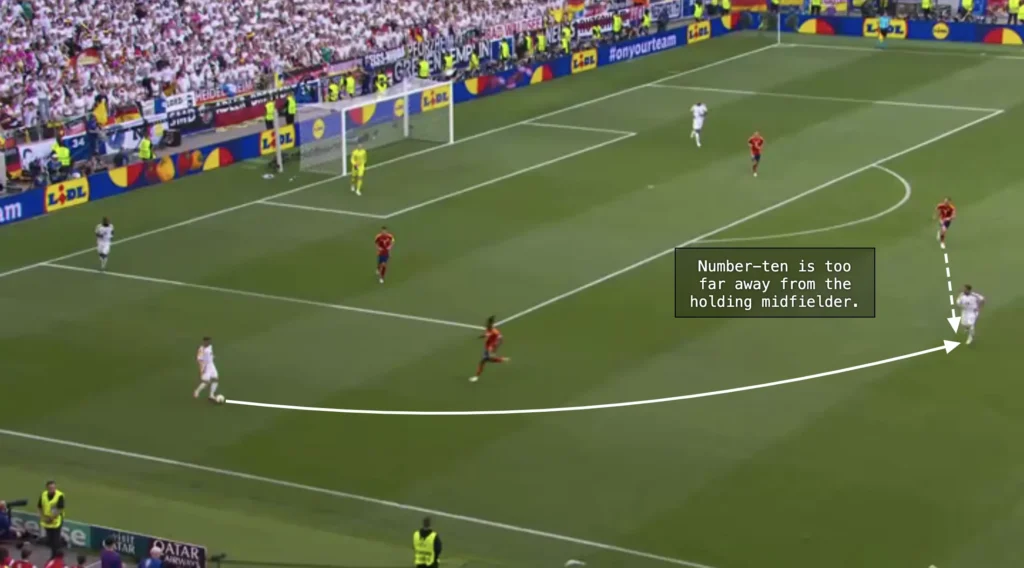
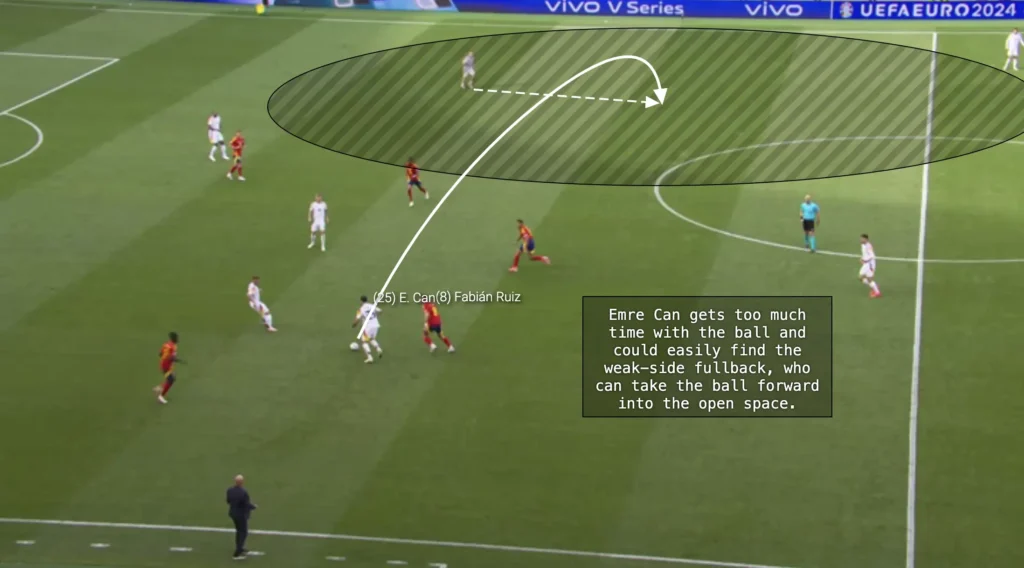
Mid/Low Press
In the mid/low press, it is very dangerous to leave the number-six isolated without any horizontal cover. Therefore, the wise thing to do is to drop the wide attacking midfielders down next to the number-six, creating a 1-4-3-1-2 formation.
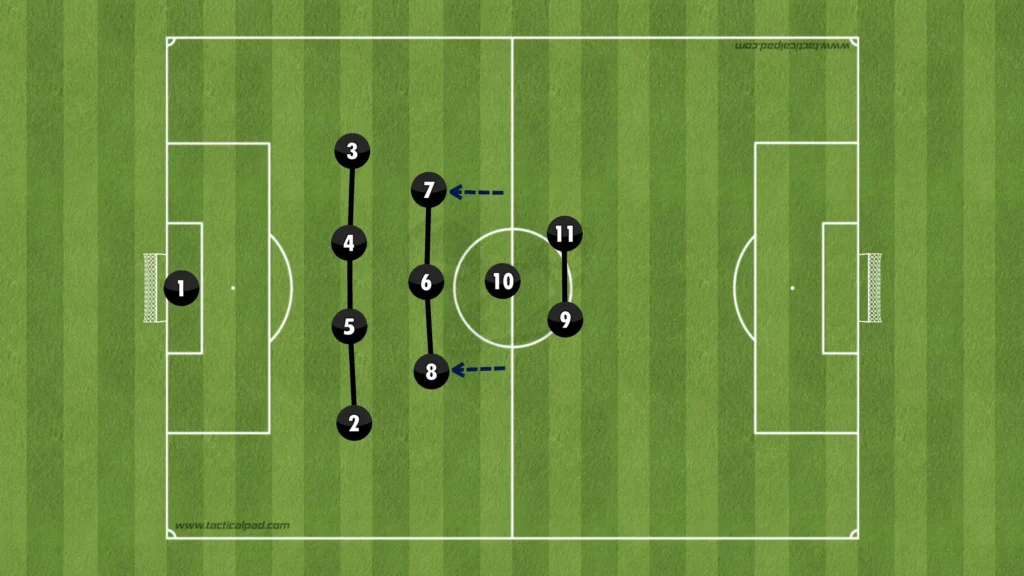
Closing the center
The advantage of defending in this formation is that it naturally closes the center and forces the opposition out to the flanks. It blocks off most ways towards the goal and when staying compact, it is difficult to break down.
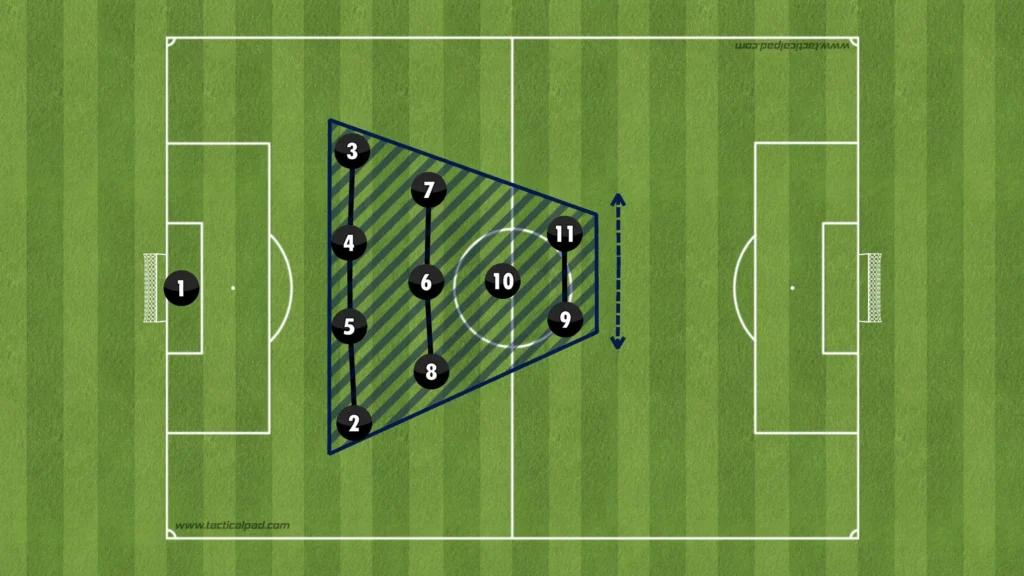
How to deal with wide advancements
When the opposition progresses the ball on the wing, for example through a fullback, the ball-side central midfielder needs to break out and stop the fullback from advancing. Then, the other two central midfielders need to shift across to close the center. This often leaves big spaces on the other side. However, the long switch is difficult to play with control, and if they make it, the players will have enough time to come across and win the ball.
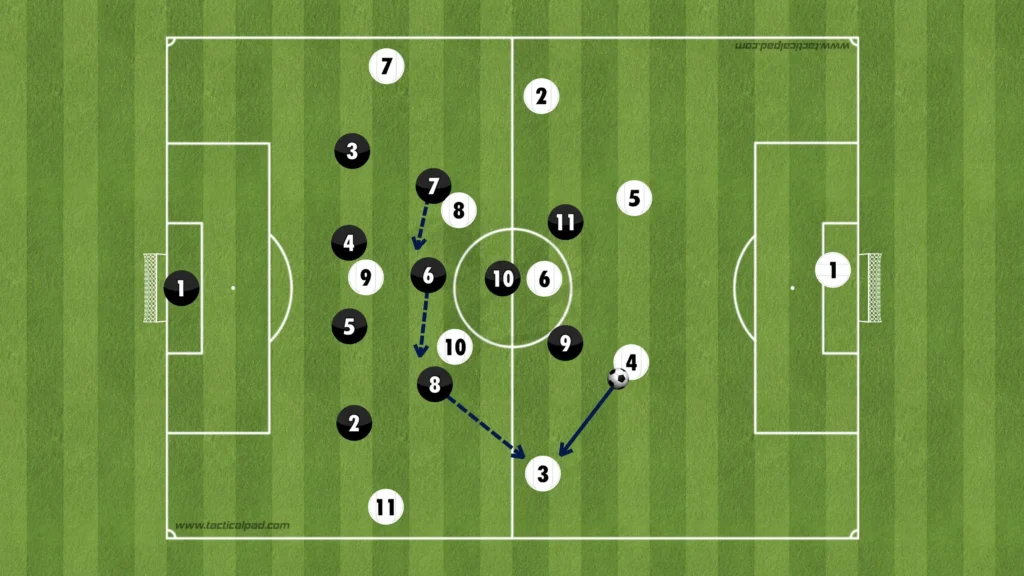
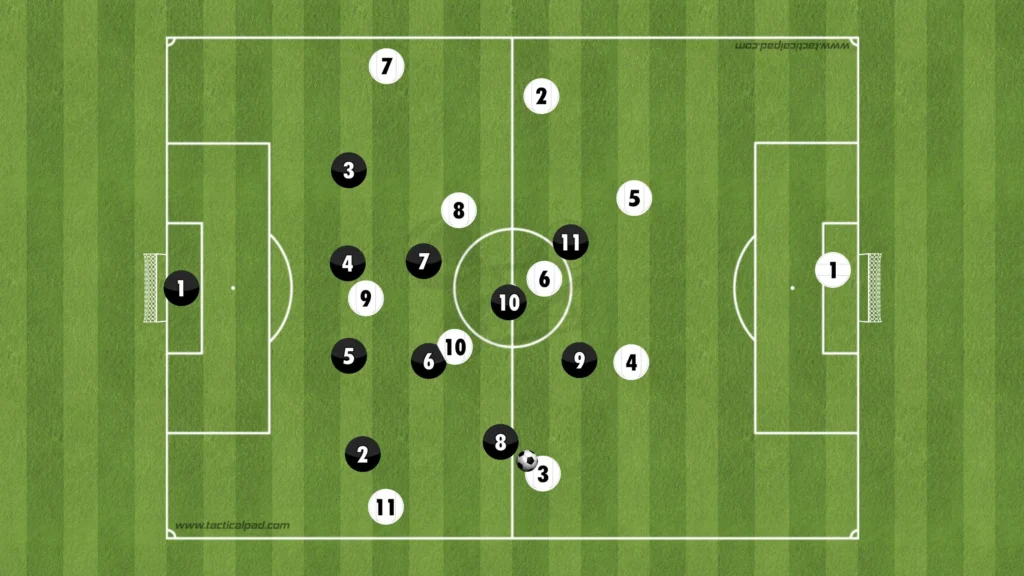
Here, the 1-4-1-3-2 defending team defends successfully. They let the opposition play on the outside and close the entries to the middle.
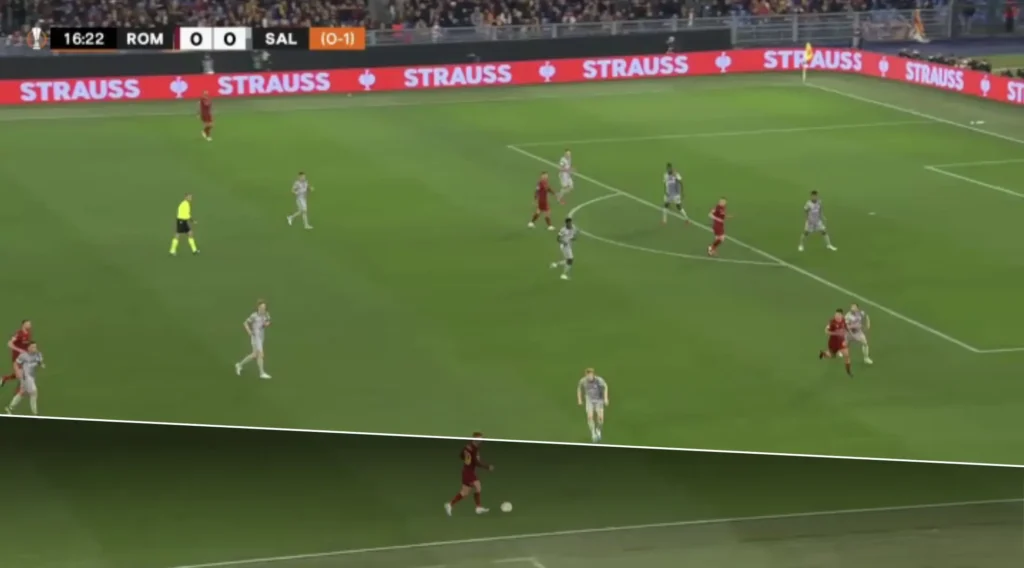
Problems with closing all spaces
Like in the high press, a common problem with this formation is that it is difficult for the midfielders to come across and close all the spaces when the opposition switches sides. The three midfielders behind the number-ten have to quickly shift over to close the center and stay compact. If you are defending during big parts of the game, this can become tiring, the midfielders can’t come over as fast, and spaces may start to appear.
The next images show situations where the midfielders are too slow to come across and close the spaces in the midfield.
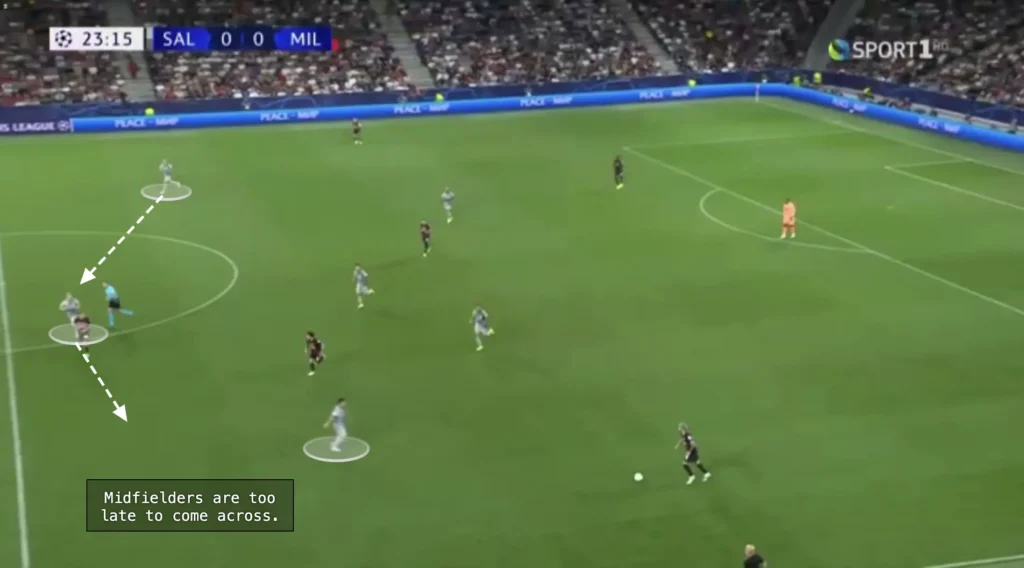
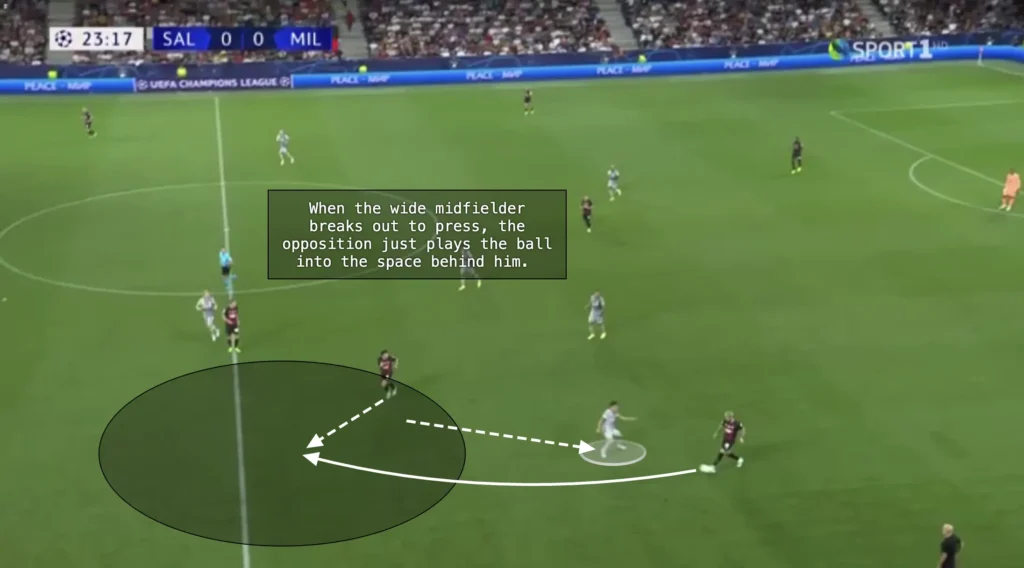
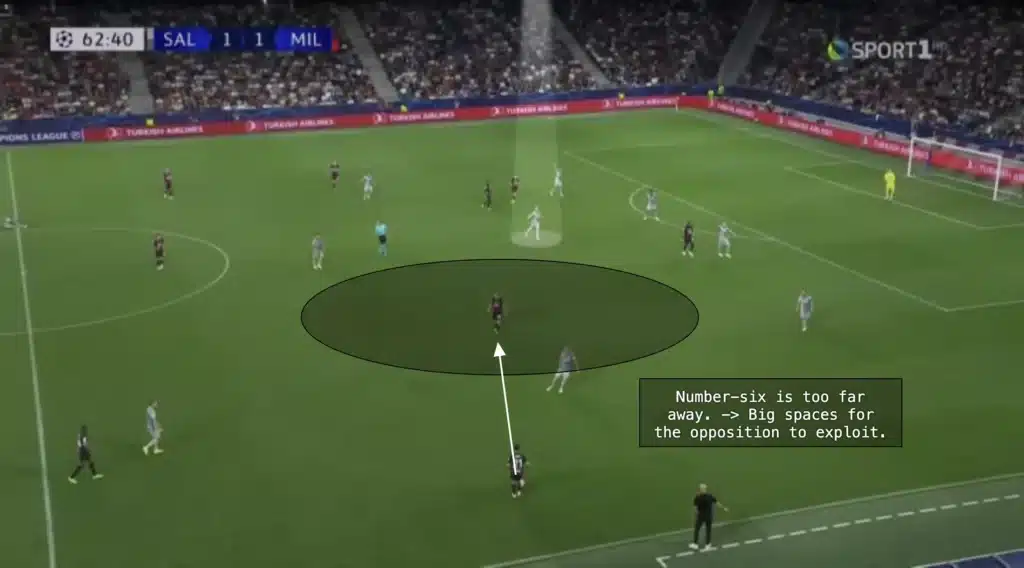
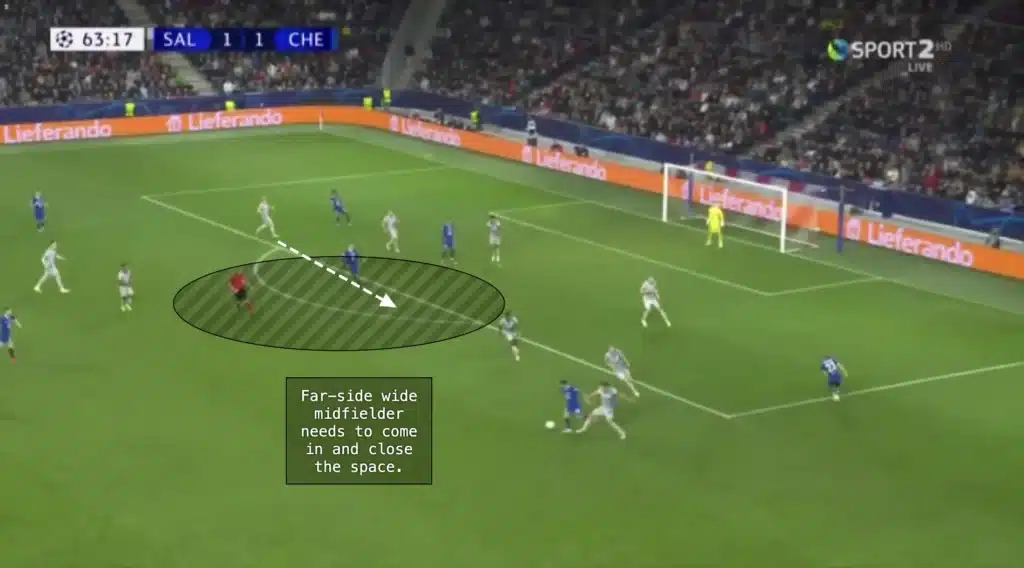
Counterattack
The 1-4-1-3-2 formation is particularly potent for counterattacks due to its two-striker setup and the support from the attacking midfielders. When the team regains possession, the strikers can quickly exploit the spaces behind the opposition’s defense, using their partnership to outmaneuver defenders. The number-ten, positioned just behind the strikers, can drive forward with the ball, creating opportunities for through-balls and quick combinations.
This is a counterattack from RB Salzburg, who play in a 1-4-1-3-2 formation, where the number-ten and strikers combine to create a goalscoring opportunity.
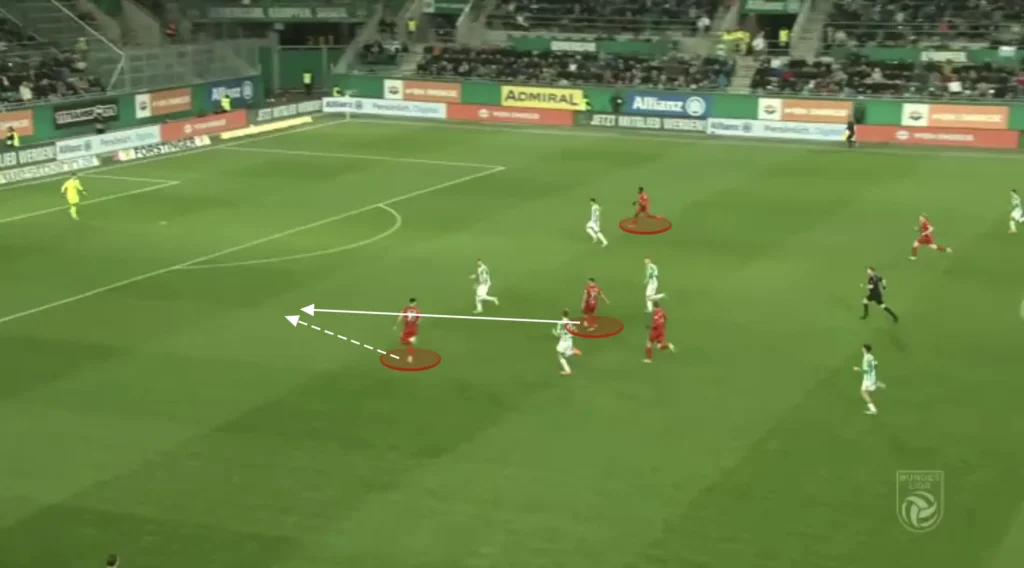
Build-up
Building up in a 1-4-1-3-2 formation focuses on creating numerical superiority and maintaining fluidity across the pitch. The formation starts with a solid defensive line of four, providing stability and width. The single number-six in midfield, often a deep-lying playmaker, acts as a crucial link between defense and attack, offering passing options and dictating the tempo. The three advanced midfielders position themselves strategically to exploit spaces and support the number-six. The two forwards stay high, ready to receive through-balls, make runs behind the defense, and create goal-scoring opportunities.
Strikers Between Defenders
For the 1-4-1-3-2 formation to be used effectively, the strikers should always be positioned between the opposition defenders. When positioned between defenders and not on the defenders, they pin more opposition players and open up more space for the midfielders. Pinning means restricting the movement of the defenders. This tactic involves positioning oneself so that the defender is forced to stay close to the attacker, effectively “pinned” to a certain area of the field. By doing so, the attacker creates space elsewhere for their teammates.
Here, the pin means that the three attacking midfielders can turn and attack the defense when receiving the ball from the backline, without being pressured by the opposition defenders. The opposition defenders will not jump on the midfielders because they don’t want to leave any open spaces for the strikers. If the strikers stand on the defenders, only two defenders will be pinned. However, if the strikers stand between the defenders, they could pin the entire backline.
Against a back four
Against a back four, the strikers should stand between the fullback and the center-back. This makes it difficult for the defenders to push up without leaving too much space for the strikers and occupies the entire backline. With the entire opposition backline occupied, the midfielders and defenders will be in a +2 numerical advantage and have way more space.
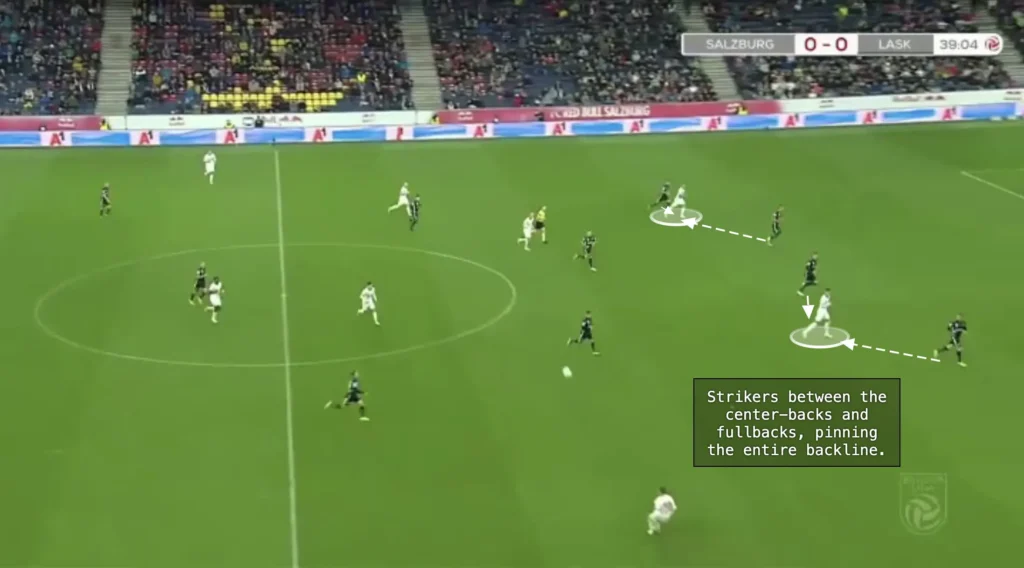
Against a back five
Against a back five, the strikers should stand between the wingback and the wide center-back. This pins these players, meaning four opposition defenders will not push up. The central center-back will be unoccupied, meaning he can push up and press. If he does this, however, a big hole opens up in the middle of the backline, which the strikers or attacking midfielders could run into to exploit.
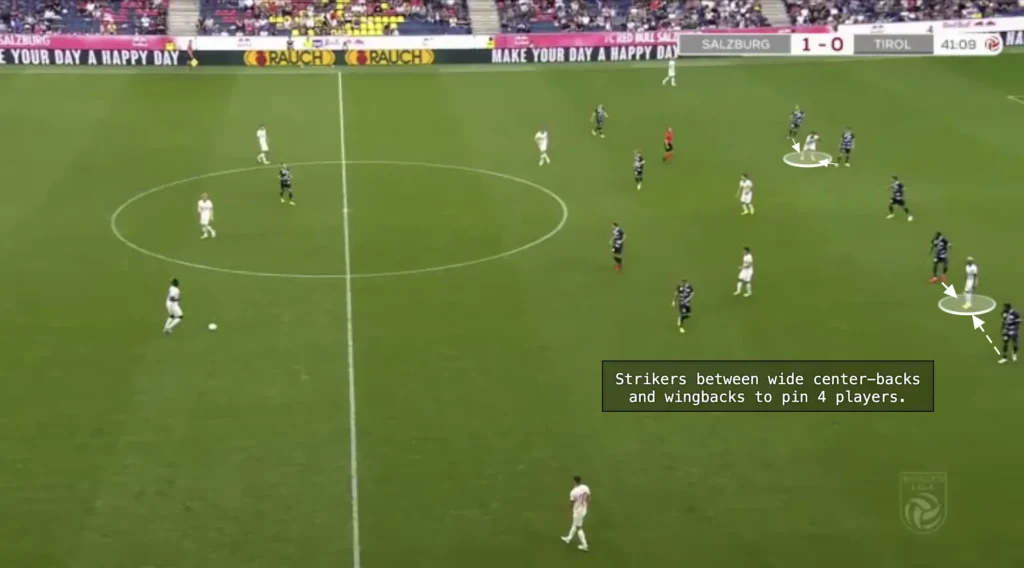
Low Build-up
The 1-4-1-3-2 formation offers a lot of flexibility in the low build-up. With no one naturally responsible for the high width, many players can move into these spaces, which creates confusion and questions for the opposition. The strikers or number-eights can rotate out into these spaces and the fullbacks could push up into these spaces. The number-eights can also, much like the number-ten, drop down next to the number-six to give more options lower down the pitch.
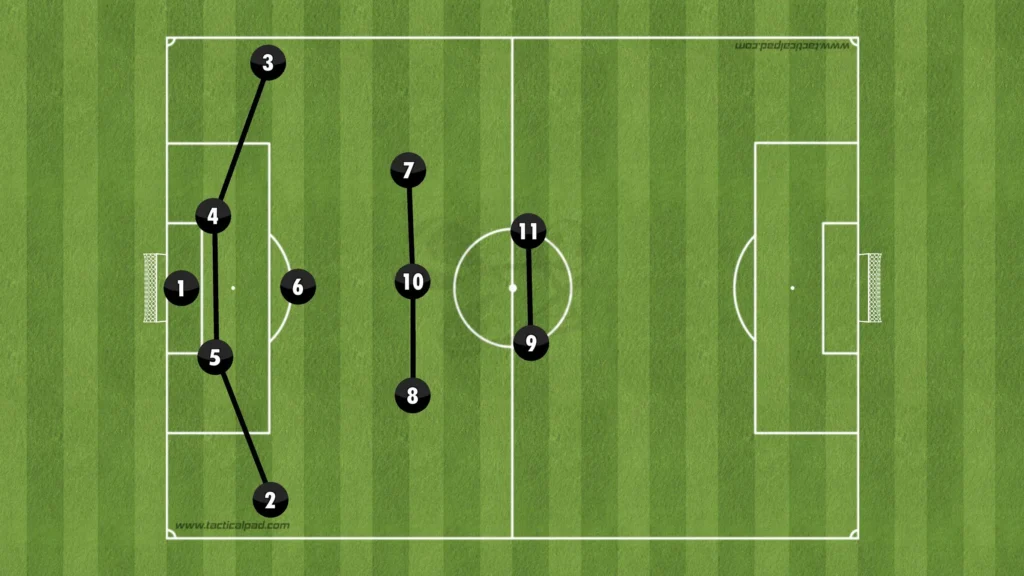
Low build-up while -2 in the forward line
Building up against a back four means you will be -2 in the forward line. Long balls should, therefore, not be very effective. At the same time, you will be +2 lower down the pitch meaning you should be able to beat the opposition’s press. Against a 1-4-2-3-1 formation, straight passes from the center-backs to the number-eights will often be effective, trying to exploit the numerical superiority against the opposition’s two holding midfielders.
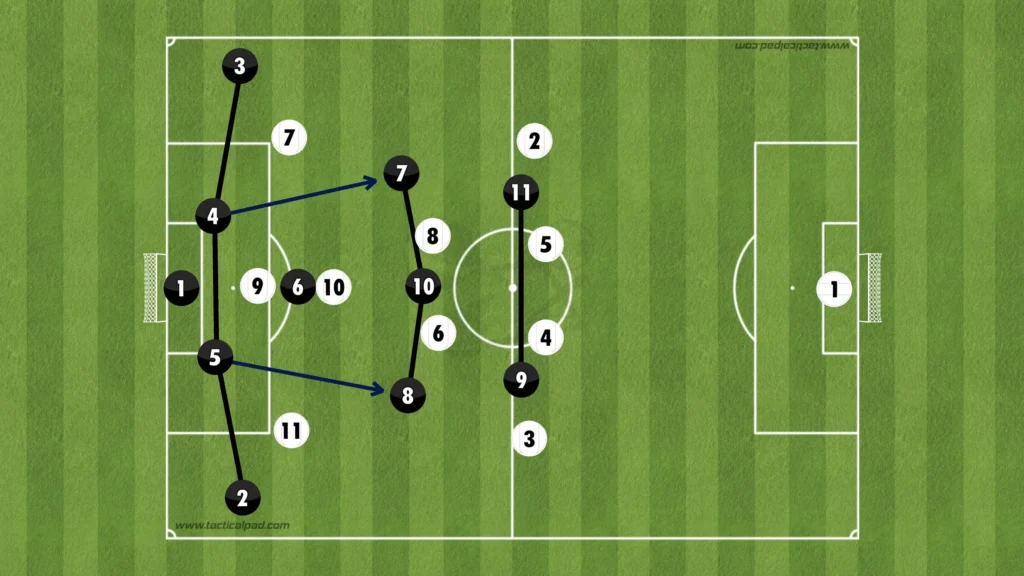
Low build-up while -1 in the forward line
Building up against a back three means you will be -1 in the forward line. Long balls should still not be very effective and the numerical advantage lower down the pitch means you should be able to beat the opposition’s press. If the opposition goes man-to-man in the midfield, you will have a 4v3 with the backline against the opposition’s forward line. This can be exploited in different ways, depending on the position of the opposition wingers. If the wingers are wide, the center-backs can take the ball forward through the gap between the striker and the winger. If the wingers come in to press the center-backs, the fullbacks will be open to receive the ball and take it forward
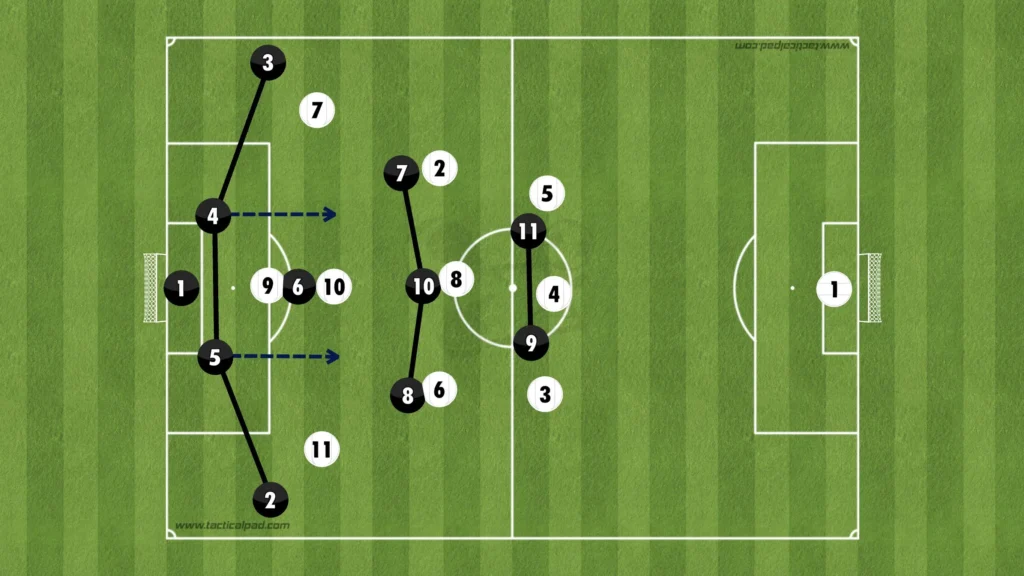
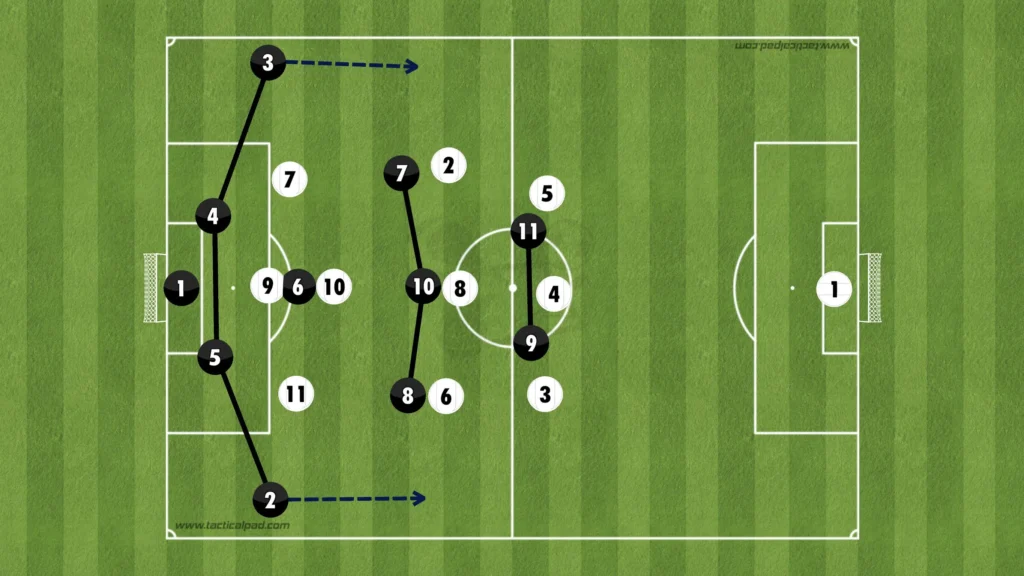
Low build-up vs man-to-man system (numerical equality)
If the opposition comes up and presses man-to-man, there will be a 5v5 high up the pitch to compete for a long ball. The two strikers can work together to win the first ball and the three attacking midfielders can work together to win the second ball. The attacking midfielders must get around their opponents and anticipate where the second ball will land when the long ball comes.
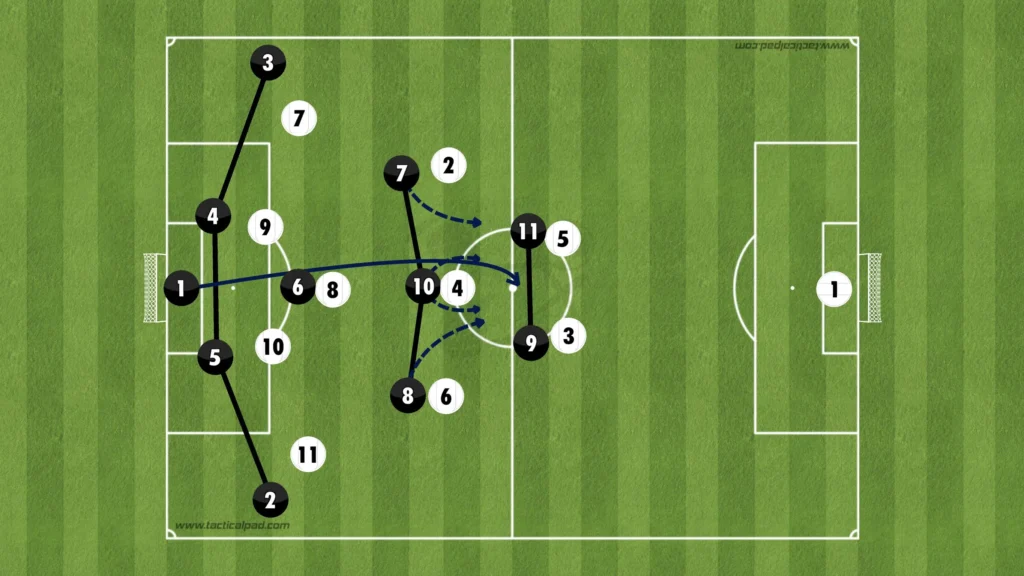
Here, a long ball is played and the three attacking midfielders work together to win the second ball, leading to a goalscoring opportunity.
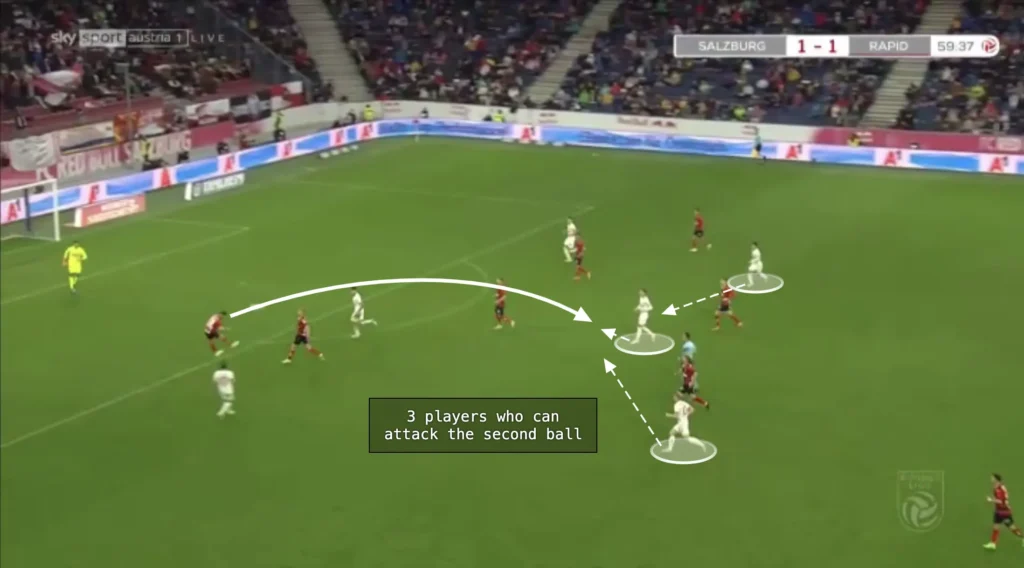
High Build-up
The 1-4-1-3-2 formation offers perhaps even more opportunities for flexibility in the high build-up. Once again, the strikers or number-eights can rotate out into the wider areas and the fullbacks could push up into these spaces to create attacking width. If the strikers come wider, the number-ten can push up to question the opposition center-backs. The number-eights can also, much like the number-ten, drop down next to the number-six to give more options lower down the pitch.
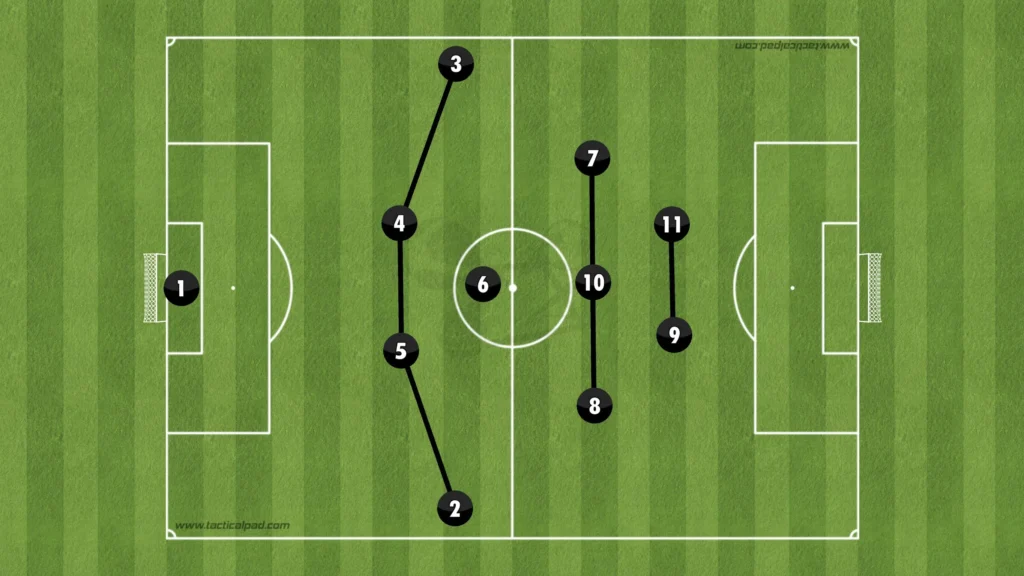
Numerical Advantage in the Midfield
With four central midfielders, you will almost always have a numerical advantage in the midfield. This means at least one midfielder will always be open.
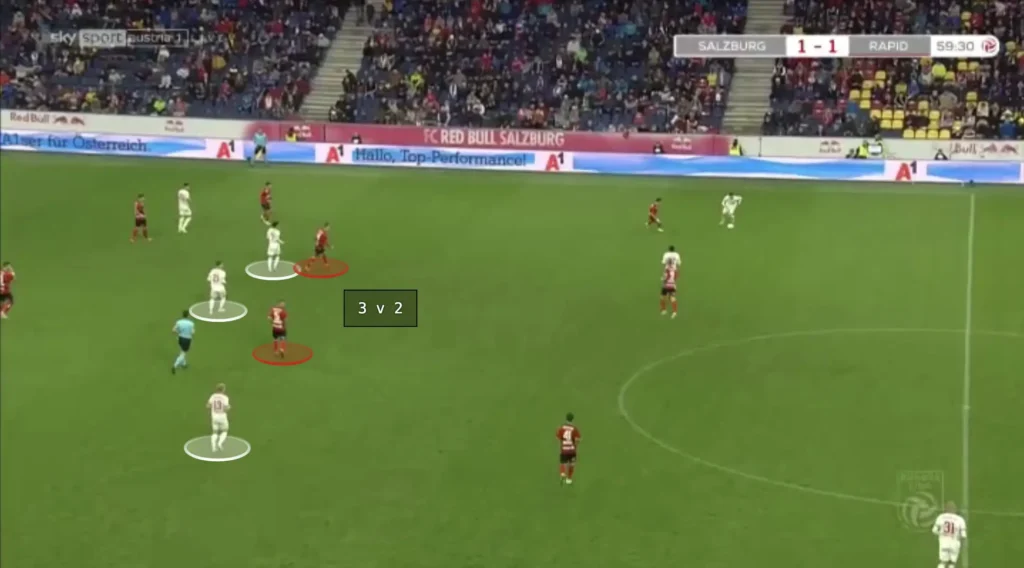
Having only the two fullbacks out wide and the rest in the middle creates more options in the center and less space between the players. Therefore, 1-4-1-3-2 playing teams should prioritize playing through the middle. You will have one player out wide to pull the opposition apart while the rest create numerical advantages in the midfield areas. This builds good conditions in defensive transitions, allowing more players to counterpress when losing the ball. Another purpose for keeping many players in the middle is to shorten the distance between them. This shortens the length of the passes, which naturally shortens the time between passes. This means the opposition players will have less time to push up and press, giving the players more time and control with the ball.
Finding the number-ten
The number-ten plays an important role in the 1-4-1-3-2 formation. Considering his advanced position, he will be the main person to find in the build-up. With the strikers pinning the backline, the number-ten will often be able to turn when receiving the ball. When he gets the ball, he will be behind the opposition’s midfield, allowing him to drive at the defense and play decisive through-balls to the strikers.
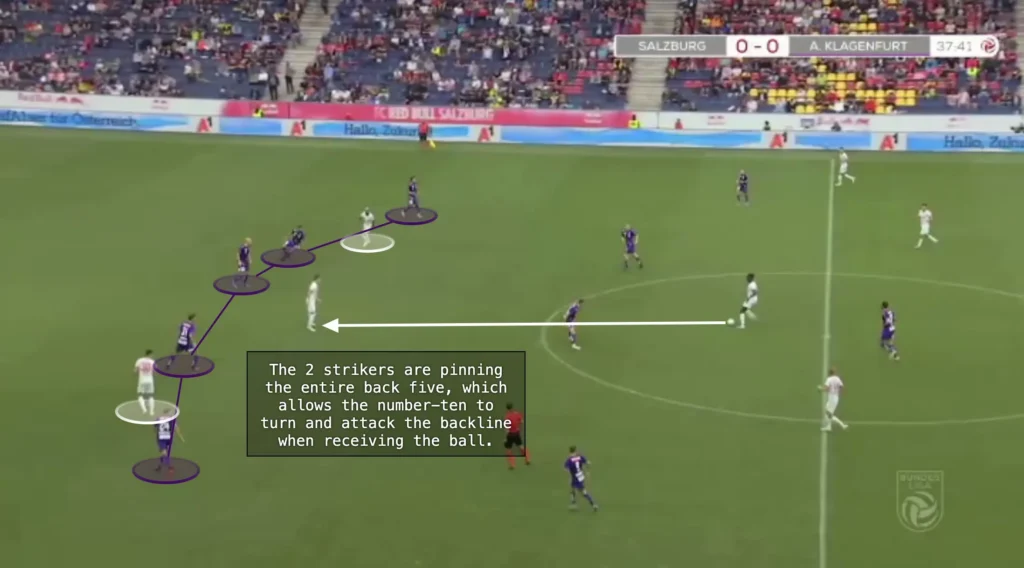
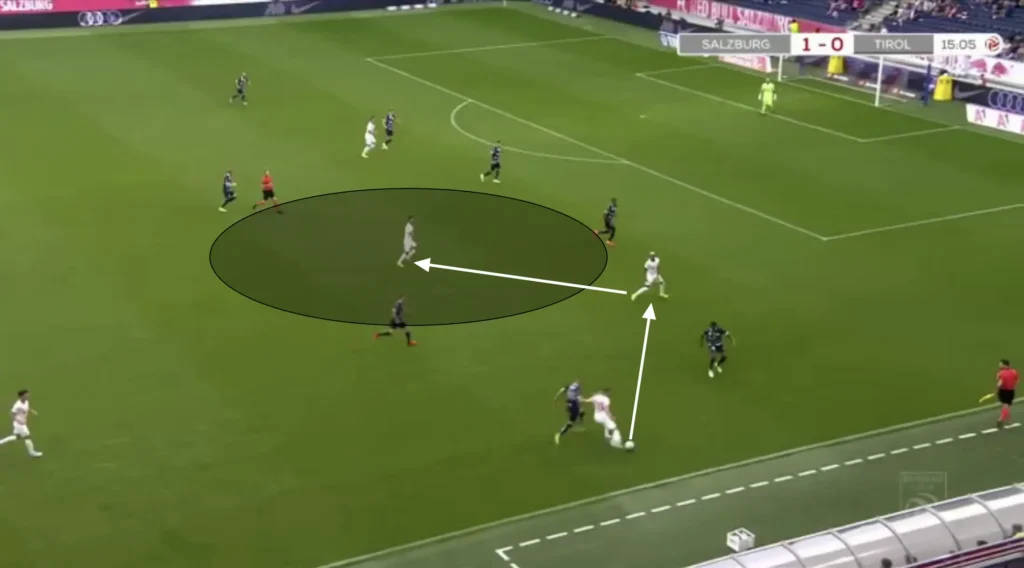
Free player on the diagonal
Because of the danger of letting the number-ten receive the ball, many teams try to close that player off as much as possible. This opens the space for a different midfielder, usually the far-side number-eight. The diagonal pass from the backline to the far-side number-eight is often open and a great way to beat the opposition lines and progress the ball forward.
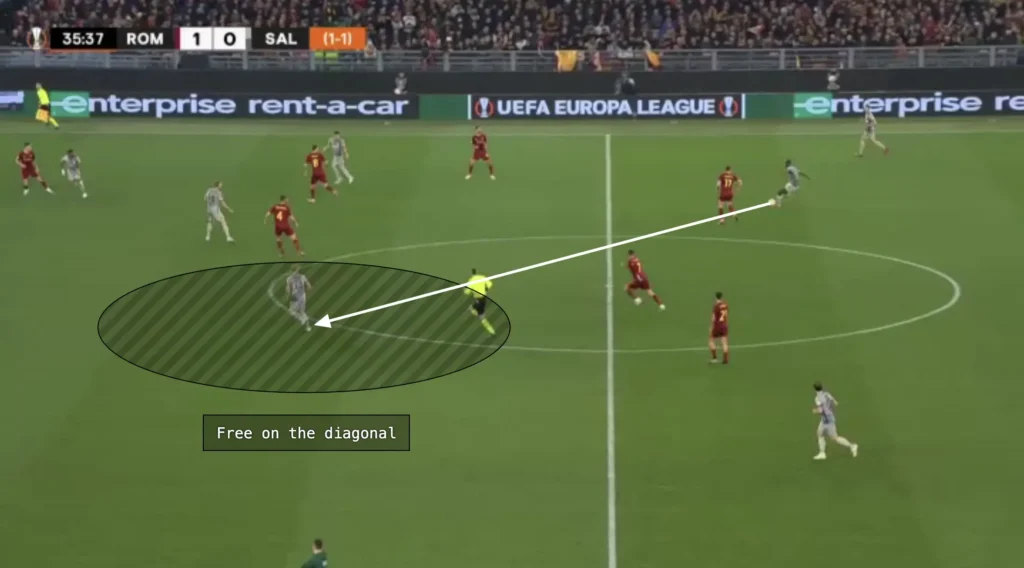
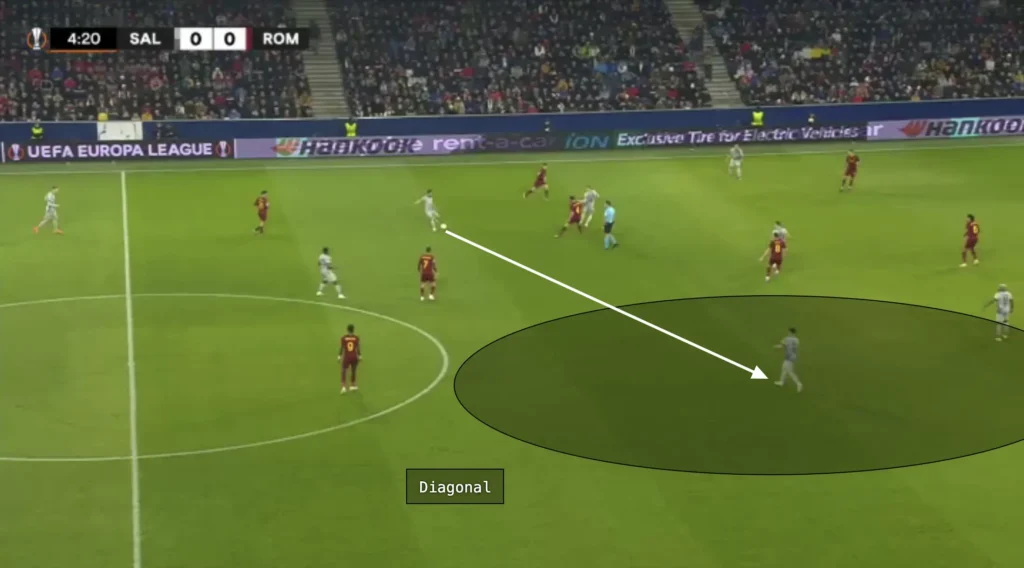
Fullbacks wide to pull apart the midfield
In a 1-4-1-3-2 formation, the fullbacks need to be very wide. This forces the opposition wingers to be wide, which pulls apart the opposition’s midfield. With big spaces between the opposition midfielders, the passing lanes from the center-backs to the midfield will be more open, which is important considering you want to play through the middle in this formation.
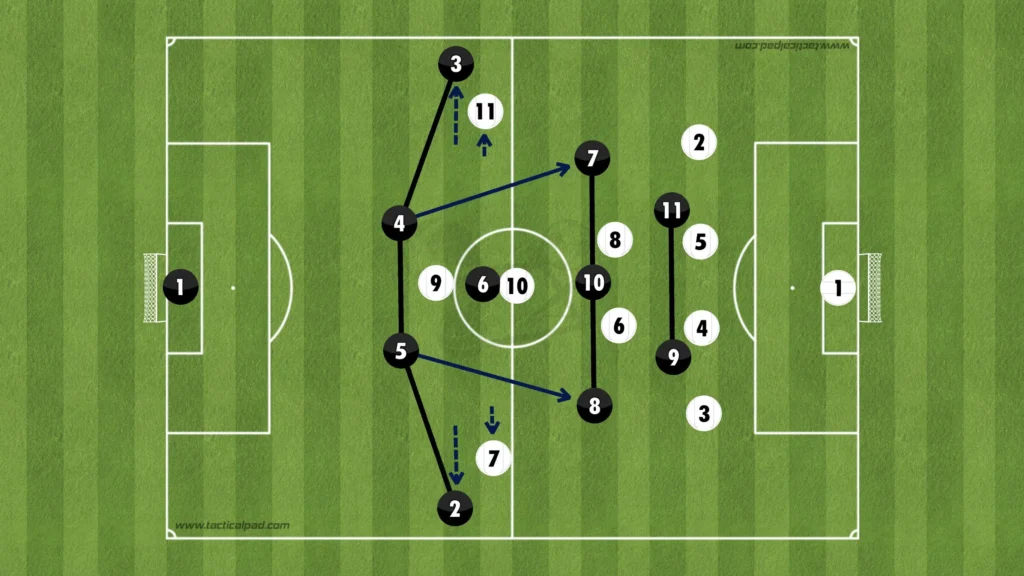
Fullbacks pushing up
The 1-4-1-3-2 formation provides no natural width because of the lack of wingers or wide midfielders and as such, the fullbacks have the responsibility of pushing up to exploit spaces in the wide areas.
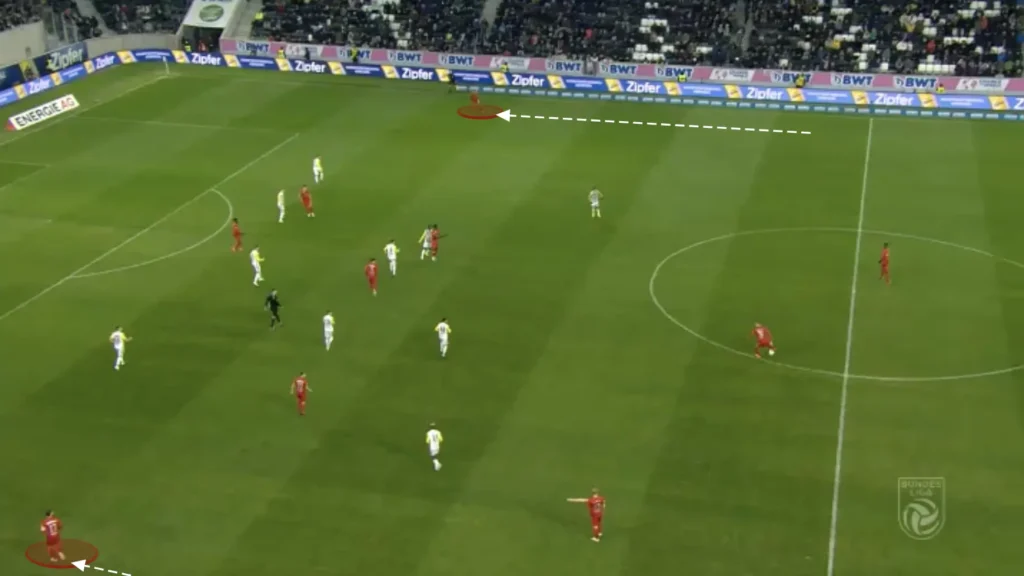
Here, Salzburg’s fullbacks push up and are found out wide in acres of space, allowing them to take the ball forward and deliver a cross.
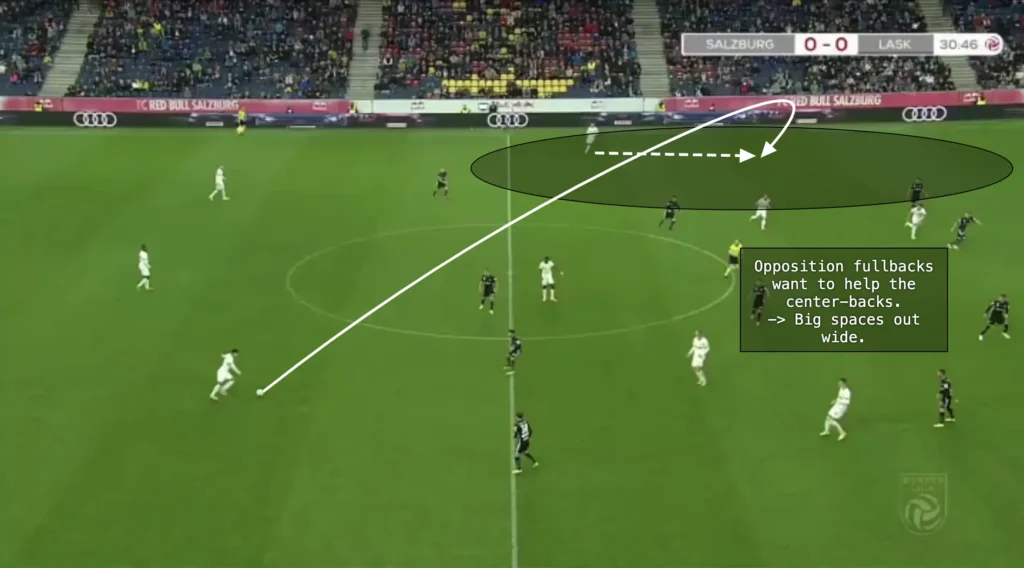
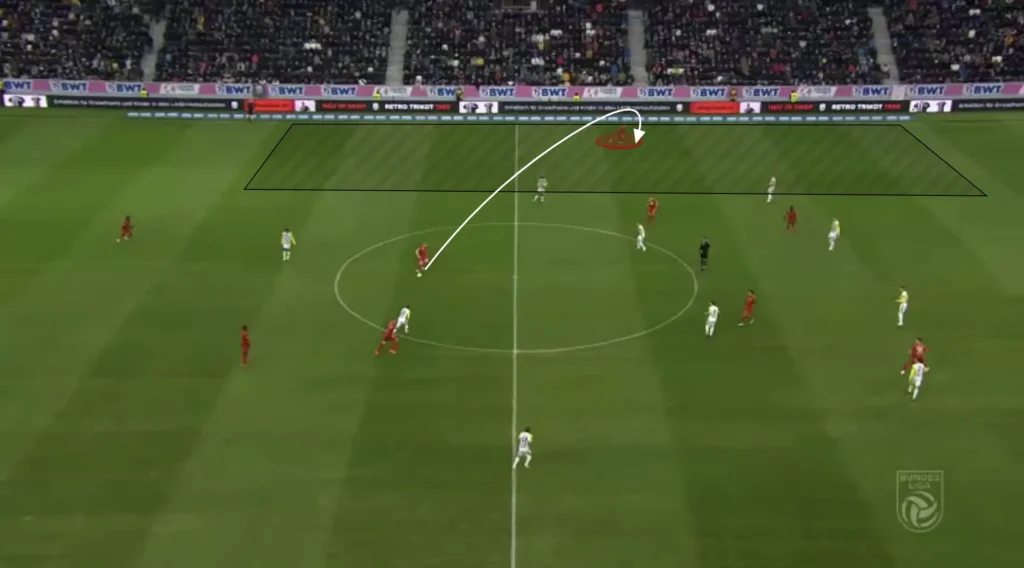
Many players high up the pitch
In the 1-4-1-3-2 formation, many players will naturally be high up the pitch in attack. With two strikers, three attacking midfielders, and two attacking fullbacks, seven players will be very high and can, for example, overload the box in crossing situations. The overloads in the box increase the chances of connecting with the cross, as more players present multiple targets for the crosser, making it harder for defenders to mark everyone effectively. Additionally, having multiple players in the box provides options for different types of finishes, whether it’s a header, volley, or a quick tap-in. It also allows for better positioning to react to second balls or rebounds, increasing the likelihood of capitalizing on any defensive errors.
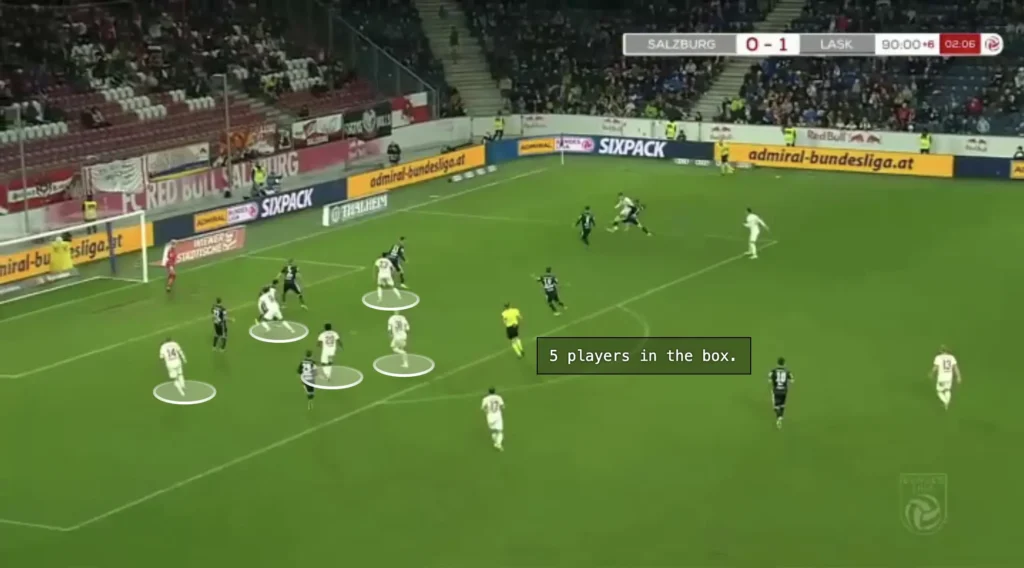
Exposure to counterattacks
The 1-4-1-3-2 formation, while offering numerous attacking advantages, can leave a team vulnerable to counterattacks. With seven players positioned high up the pitch—two strikers, three attacking midfielders, and two fullbacks—there is often limited defensive cover, particularly if the team loses possession unexpectedly. The center-backs can find themselves outnumbered or isolated, especially if the defensive midfielder is unable to provide adequate support. This exposure can lead to dangerous counterattacking situations for the opposition, who can exploit the open spaces left behind.
Here, the opposing team wins the ball in their own half and gets a 4v3 counterattacking situation, which should be a certain goal with good individual quality.
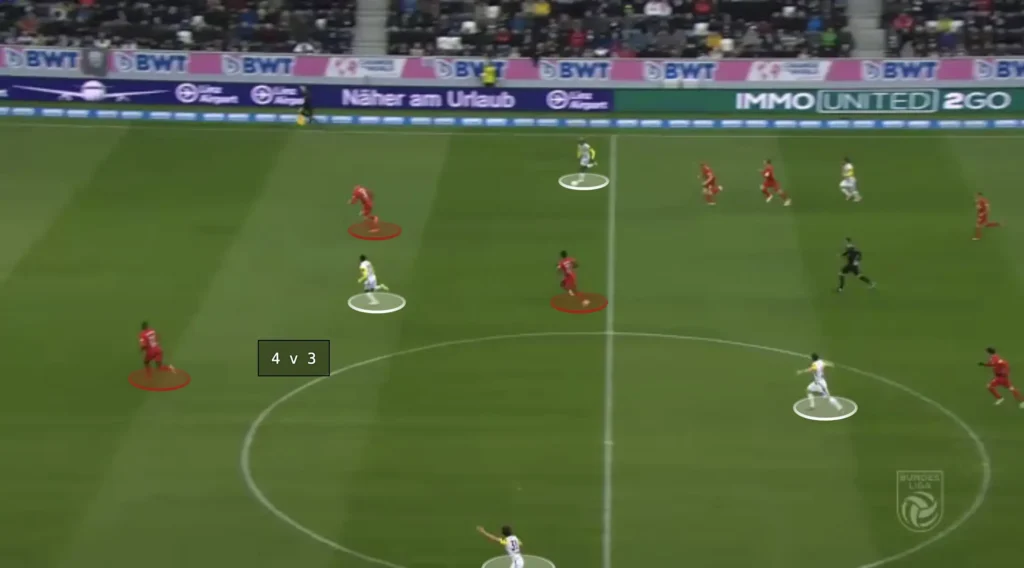
Advantages of the 1-4-1-3-2 formation
- Creates numerical advantages in the midfield
- Compact defensive shape
- Flexible => Unpredictable
- Good conditions for counterattacks
- Many players high up the pitch, allowing you to create overloads in the box.
Disadvantages of the 1-4-1-3-2 formation
- No natural responsibility for the high width in attack => The opposition backline can be very compact
- Difficulties with switch of play during the high press
- High demands of the central midfielders when defending
- Limited cover in wide areas
- Exposure to counterattacks
Final Thoughts
The 1-4-1-3-2 formation offers a dynamic approach to both defense and attack, with its structure allowing for flexibility and fluidity on the pitch. By understanding how to press effectively, manage build-ups, and execute counterattacks, teams can leverage the strengths of this formation to dominate their opponents. However, like any tactical setup, it comes with its challenges, particularly in managing transitions and maintaining defensive solidity during counterattacks. Mastering the intricacies of the 1-4-1-3-2 can provide a strategic edge, making it a valuable formation for teams seeking to control the game and exploit their opponent’s weaknesses.
